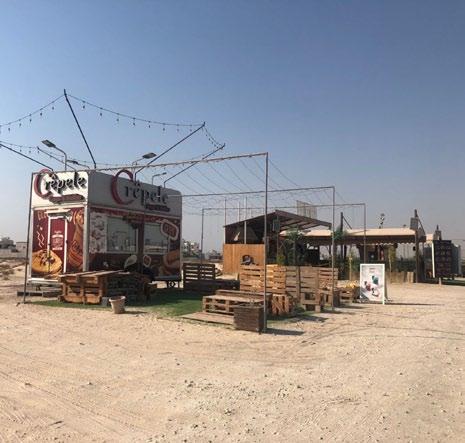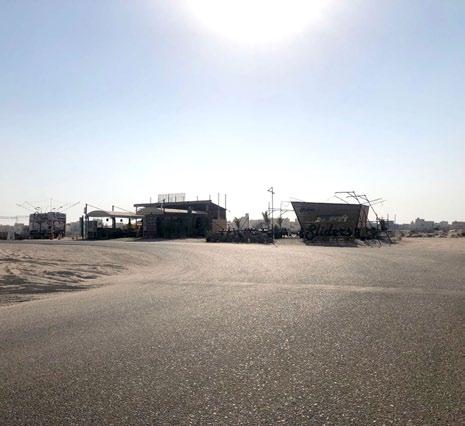
7 minute read
Are food trucks part of our landscape Architecture?
By: Islam El Ghonaimy, PhD and Dalia Eldardiry, PhD
Different shapes and style in creating Food trucks (Truck, 2017)
Advertisement
Food trucks are a phenomenon of the past few years, scattered across cities serving the community with various types of cuisine. These metal trucks are now firmly part of our urban landscapes, mostly located in open spaces within urban areas. As bricks and mortar restaurants closed last year due to COVID 19 lockdown measures, food trucks seized the opportunity to increase their business and thus, we witnessed more and more trucks pop up throughout our cities. However, this can be a cause for concern for municipalities due to the unplanned location, haphazard positions and an increase in numbers of these food trucks in cities. Therefore, this phenomenon should have guidelines to improve residents’ daily lives. Moreover, it will enhance the open space conditions and add value to different levels, not only services and economic sectors.
These food trucks produce various types of food, and many visitors come to them, especially in the pleasant weather because of their location. Even before the Corona pandemic happened, the outside tables were full of customers. The location of the food trucks is a major factor for customers when choosing to dine, parking for example is a huge bonus for customers. Peak timing for food trucks is during the afternoon and at sunset as customers want to sit outdoors without being in the direct sunlight, however this may become less of a factor during winter when the sun is much cooler during the day. During the
Corona pandemic, people wanted to go out to any place that could hold beautiful outdoor sessions in the open air. This was the quarantine’s effect and the precautions that were followed by the government, so the best place to go out was walkways, parks and streets. Most of the areas with food trucks have ideal conditions for visitors, as they are surrounded by the sea, grass and trees and normally have good parking options.
Moreover, selecting a proper location for a group of food trucks depends on a variety of factors including time, place, and activities. Consequently, it will influence the qualitative performance of the open space. In the last few years, it became one of the elements that engaged in designing open spaces, especially designing parks or vacant areas to harmonize with buildings and roads.
Historically, food trucks are ancient, and significant
Food trucks activities:
In the gulf region, since the food trucks are the dynamic and mobile element that could be moved from one place to another, there is a need to understand the diversity and similarities of open space use for food trucks, and developing the theory of location attachment in times and places of displacement and change of location. The overarching interest in the transnational city, a conceptual lens that can challenge notions of singular normality notions concerning place value, is emphasized within both of these ambitions. Health practices such as urban leisure walking can be understood as representing a growing sense of sporadic autonomy for people in terms of expression of meaning, bringing food to parks can promote loose social ties and a tacit interdependence. Moreover, the idea of a food truck, provides an insight into the diversity of recreation in a country characterized by a harsh climate, with the need of comprehensive state regulation of public conduct while proposing the location, preparation for space, implementing the idea and the operation and followings progress. (Addas, A. and Rishbeth, C., 2018) occupation is found worldwide in virtually every country and major city. It is part of the street vending commercial activities. Street vending and the sales can be anything from a strategy of survival to a desperate search for income from subsistence to small capitalism, or diversification of huge business to boost demand as well as boost turnover while food trucks are mobile services, which mainly are for different types of foods services. (Anon., 2020). For instance, for a long time in the old part of Manama in the Kingdom of Bahrain, within the concept of “Al-Farej” there were different types of street vending in different areas serving the Al-Farej with cooked food. To maximize their reach and capture trade from passers-by, the vendors are located in the main spines of the city; the main roads,
corridors and passages within the surrounding urban area.
Figure 2: Food trucks, in urban areas Amwaj Islands, Bahrain (photos by the authors)

Food trucks and landscape architecture:
In Bahrain for example, there were many locations selected to host food trucks, which are nearby famous places or landmarks such as the American Mission Hospital, Al salam hospital, Zalaq perto; station, Karbbabad, the Alosra supermarket and the residential area of Amwaj Islands and Lagoon, which is visited by people from all regions of Bahrain. .
Most of the food trucks have sitting areas. The visitors usually park their cars in the parking lot and site in the sitting area in the truck’s side. That’s generally happing in good weather. But dangerously, some of the visitors’ park in the middle of the street causing traffic while ordering from the tracks The study found that some food trucks were located in improper sites, with no landscape criteria or urban concern, causing traffic and urban problems.


Figure 4: Miss site location (Random) for the food trucks causing landscape problem (photos by the authors)


Authorities used rules and regulation to operate and manage the selecting of sites’ location. The national stadium, some scattered vacant areas and near the central market were proposed to have these food trucks. According to the interviews by users, they prefer to find the food trucks nearby the recreation areas when they used to be outgoing.

Figure 3: Food trucks, in sub urban in Zalaq district, Bahrain (photos by the authors) Figure 5: Food trucks in specific site by the authority (photos by the authors)


Attracting 160,000 visitors in a month, amid the COVID 19 pandemic, is no mean feat. Food truck areas has become the attraction point for food lovers in Bahrain. The latest data shows that the area dubbed “District” is a hit among connoisseurs of good food in the Kingdom. On 22nd October 2020, in Bahrain National Stadium, East Riffa, 50 mobile food trucks in the national stadium offered numerous dishes (local and international cuisines). This event run by Industry, Commerce and Tourism Minister, Zayed bin Rashid Alzayani was launched to support promising Bahraini projects and to empower food truck owners, the ‘District’ has played an essential role in creating a suitable environment for the foodtruck industry Bahrain. (BNA(R), October 23, 2020)

Finding of the study:
Food trucks are a significant sustainable element that have environmental, social and economic impacts upon landscape architecture. Environmentally, the recycling of vehicles to save the environment by decreasing the amount of metal waste. Socially, it is one of the ways for people to take an informal, affordable and easy-to-reach picnic. People enjoy the ease and simplicity of food trucks, they can also encourage group activities, including hiking and
Figure 6: 50 food trucks in the national stadium areas to attract 160.000 gourmets, run by Industry, Commerce and Tourism Minister (BNA(R), October 23, 2020)

eating at relatively affordable prices, especially during the Corona pandemic. Moreover, it is a source of income for people working in it by providing jobs for workers and a simple way to start a business for people with limited capital that may allow them to expand. There also a source of revenue for governments with permits and taxes required to operate in public spaces.
Food trucks played an important role during the COVID 19 pandemic (lockdown period) following the WHO precaution (social distancing and outdoor socializing). Food trucks should use the different elements of the landscape architecture design elements (hard and soft scape). Finally, from the landscape architecture point of view, the research recommends using the main design frames showing in figure 7 while dealing with the food trucks to achieve sustainable and resilience design for the outdoor spaces in cities.
Credit to Department of Interior Design, College of Engineering, College of Design, Imam Abdulrahman Bin Faisal University, SA eslam_elghonaimy@yahoo.com deldardiry@iau.edu.sa
Figure 7: the main design frames showing in figure 7 while dealing with the food trucks to achieve sustainable and resilience design






